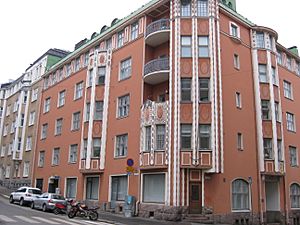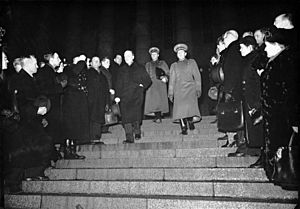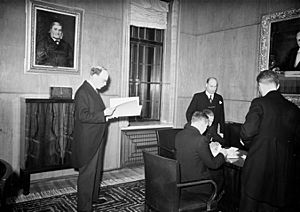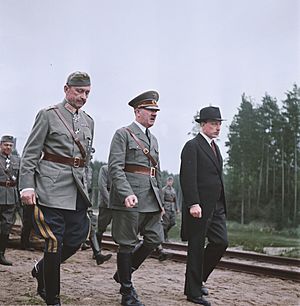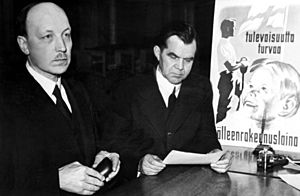Risto Ryti facts for kids
Quick facts for kids
Risto Ryti
|
|
|---|---|
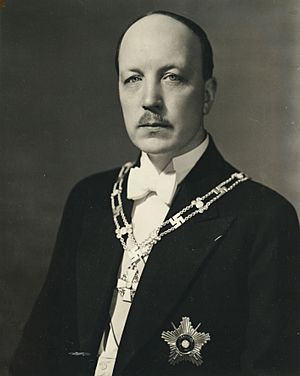 |
|
| 5th President of Finland | |
| In office 19 December 1940 – 4 August 1944 |
|
| Prime Minister | Jukka Rangell Edwin Linkomies |
| Preceded by | Kyösti Kallio |
| Succeeded by | C. G. E. Mannerheim |
| 14th Prime Minister of Finland | |
| In office 1 December 1939 – 19 December 1940 |
|
| President | Kyösti Kallio |
| Preceded by | Aimo Cajander |
| Succeeded by | Jukka Rangell |
| Minister of Finance | |
| In office 14 November 1922 – 18 January 1924 |
|
| Prime Minister | Kyösti Kallio |
| Preceded by | Ernst Gråsten |
| Succeeded by | Hugo Relander |
| In office 9 April 1921 – 2 June 1922 |
|
| Prime Minister | Juho Vennola |
| Preceded by | Jonathan Wartiovaara |
| Succeeded by | Ernst Gråsten |
| Personal details | |
| Born |
Risto Heikki Ryti
3 February 1889 Huittinen, Grand Duchy of Finland, Russian Empire |
| Died | 25 October 1956 (aged 67) Helsinki, Finland |
| Political party | National Progressive |
| Spouse | Gerda Ryti (née Serlachius) |
| Children | Henrik Ryti Niilo Ryti Eva Saxén (née Ryti) |
Risto Heikki Ryti (3 February 1889 – 25 October 1956) was an important Finnish politician. He served as the fifth President of Finland from 1940 to 1944. Before that, he was the prime minister during the Winter War (1939–1940). He also led Finland during the Continuation War (1941–1944).
Ryti was known for his knowledge in economics and banking. He made many international friends in the financial world. After World War II, Ryti faced trials for his decisions during the war. He was found responsible for some wartime actions.
In 1944, Ryti signed an agreement with Nazi Germany, known as the Ryti–Ribbentrop Agreement. This deal promised German military help for Finland. In return, Finland agreed not to make a separate peace with the Soviet Union. Ryti resigned soon after, which allowed his successor, Mannerheim, to make peace with the Soviet Union.
Contents
Early Life and Education
Risto Ryti was born in Huittinen, Finland, in 1889. He was one of seven sons in a farming family. Ryti loved books and learning from a young age. He didn't spend much time working on the family farm.
He went to Pori Grammar School briefly. Then, he was taught at home before going to the University of Helsinki in 1906. There, he studied law. Ryti was the only one of his brothers to pass the university entrance exam.
After graduating in 1909, Ryti became a lawyer in Rauma. He also continued his studies and earned a Master of Laws degree in 1912. In 1914, he went to Oxford to study maritime law. But World War I started, and he had to return to Finland. In 1916, he married Gerda Paula Serlachius. They had three children: Henrik, Niilo, and Eva.
Ryti became close friends with Alfred Kordelin, one of Finland's richest men. Ryti was Kordelin's lawyer. In 1917, Ryti and his wife saw Kordelin being killed by a Russian Bolshevik. Ryti himself was almost killed but survived.
A Career in Politics and Banking
During the Finnish Civil War, Ryti stayed hidden in Helsinki. After the war, he became very active in politics. In 1919, he was elected to the Parliament as a member of the National Progressive Party. He was one of the youngest members at 30 years old. He served in Parliament from 1919 to 1924 and again from 1927 to 1929.
Ryti was known for his strong skills in economic policy. He was seen as fair and dedicated to his country. This helped him succeed even when his party became smaller.
Finance Minister and Bank Governor
In 1921, Ryti became the finance minister at age 32. He held this position twice until 1924. As finance minister, he helped bring order to the government's money plans.
In 1923, President Kaarlo Juho Ståhlberg appointed Ryti as the governor of the Bank of Finland. He held this important job until 1939. As governor, Ryti wanted to link the value of the Finnish currency (the markka) to the gold standard. This meant the markka's value was based on a certain amount of gold. Finland adopted this in 1926. However, after the Great Depression in 1929, Finland had to stop using the gold standard.
Ryti built strong connections with banks in other countries, especially in Scandinavia, Britain, and the United States. He was even given an award from Britain in 1934 for his work in Anglo-Finnish relations. He could often call the leaders of the Bank of England to talk about money matters. He also worked with the League of Nations on economic issues.
During the 1930s, Ryti was a key figure behind the scenes in politics. He believed that the benefits of a strong economy should be shared by everyone. He was against the government getting too involved in businesses. He also disliked Socialist economics and the Soviet system. Ryti admired British culture and American free enterprise.
Prime Minister and President
Leading During the Winter War
In late 1939, Ryti was asked to become prime minister. He first tried to say no. But when the Winter War with the Soviet Union began on November 30, 1939, he agreed. He became prime minister on December 1.
Ryti and his foreign minister, Väinö Tanner, worked to end the war quickly. Finland's army fought bravely, which gave them time for talks. The Soviet Union eventually agreed to negotiations. Ryti convinced his government to make peace. He signed the Moscow Peace Treaty on March 13, 1940. This peace agreement was very difficult for Finland. It meant losing large areas of land and having to move 400,000 refugees.
Becoming President
Ryti had shown strong leadership as prime minister. President Kyösti Kallio became ill and resigned in December 1940. Because of the war, a normal election couldn't be held. So, the Parliament changed the rules. They allowed the electors from 1937 to choose the next president. Ryti was chosen with a large majority of votes.
On the day Ryti became president, December 19, 1940, President Kallio sadly died from a heart attack.
Shifting Alliances
Finland had traditionally been close to Britain. But after the Winter War, Finland's situation changed. The Baltic Sea was controlled by Germany and the Soviet Union. Finland needed new trade partners, and Germany was willing to trade.
In August 1940, Ryti agreed to secret military cooperation with Germany. It seemed likely that Germany and the Soviet Union would go to war. Ryti believed that Finland should use this chance to get back the areas it lost in the Winter War. This cooperation led to Finland joining Germany in the Continuation War in 1941. Finland also aimed to take over East Karelia, an area that Finnish nationalists had wanted for a long time.
The Continuation War
When Germany attacked the Soviet Union in June 1941, Finland at first stayed neutral. But after Soviet air raids, Finland joined the war. Ryti gave a famous radio speech explaining why Finland was fighting. He said that Finland was defending itself from attacks and trying to regain lost land. He also mentioned that Germany would fight alongside Finland.
Finnish troops quickly took back the land lost in the Winter War. They also moved into new areas. Many members of Parliament were unsure about crossing the old borders. But Ryti convinced them to continue. His ability to keep the government united helped keep up morale.
Ryti's first term as president was supposed to end in 1943. But because of the war, new elections couldn't be held. So, the Parliament re-elected him using the same special process. Ryti agreed to continue as president because he felt responsible for leading Finland into the war.
Seeking Peace
By 1943, Ryti and Mannerheim had doubts about Germany winning the war. Finland started looking for ways to make peace with the Soviet Union. In June 1944, the Soviet Union launched a major attack. Finland's relationship with Germany was already difficult because Finland had tried to make peace on its own.
The Finnish government tried to negotiate peace. The Soviet Union said it would only talk if Finland surrendered completely. This demand caused disagreements within the Finnish government. Finland desperately needed food, weapons, and ammunition.
The Ryti–Ribbentrop Agreement
At this critical time, German foreign minister Joachim von Ribbentrop visited Finland. He asked Finland to promise to keep fighting the Soviet Union. In return, Germany would send military aid. Ryti wanted Parliament to decide, but a private letter was suggested instead.
Ryti and Mannerheim agreed on a compromise. Ryti sent a personal letter to Germany. This letter, called the Ryti–Ribbentrop Agreement, promised that Finland would not make a separate peace without Germany's approval. After this, Germany sent military and food aid. This help allowed Finland to stop the Soviet attack in the battle of Tali-Ihantala.
In mid-July, the fighting front became stable. Ryti resigned as president on August 4, 1944, saying it was for health reasons. The Finnish Parliament then appointed Mannerheim as president. Ryti's resignation was important. It allowed Mannerheim to make peace with the Soviet Union without being bound by Ryti's personal agreement with Germany.
Later Life and Legacy
War-Responsibility Trials
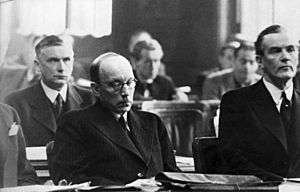
After resigning, Ryti returned to his old job as governor of the Bank of Finland. But in 1945, Finnish communists and the Soviet Union demanded that he be tried for his role in the war. Ryti was sentenced to 10 years in prison. Seven other high officials were also sentenced.
The trial used a special law created just for this purpose. Finland faced strong pressure from the Soviet Union and the United Kingdom during the trial. Ryti's health became very poor in prison. He had a tumor removed and developed arthritis. By 1949, all the other people convicted in the trials had been released. Ryti was in the hospital. President Juho Kusti Paasikivi pardoned him that year.
Final Years
After being freed, Ryti did not return to public life. He tried to write his memories, but his health problems made it difficult. In 1952, he received an honorary badge at a university event.
Even though he stayed out of politics, Ryti continued to vote. In May 1956, just five months before he died, he received an honorary doctorate from Helsinki University.
Risto Ryti passed away in October 1956. He was buried with full presidential honors.
Remembering Risto Ryti
After the Soviet Union broke apart, Ryti's reputation in Finland was largely restored. The Finnish government believes that an official pardon is not needed because his honor was never truly lost.
In 1994, a statue of Ryti was placed near the Parliament House in Helsinki. In 2004, in a Finnish TV series called Great Finns, Risto Ryti was voted the second greatest Finn.
Beliefs
Risto Ryti was a Freemason. He joined in 1924 but was not very active. After his prison sentence, he had to give up his membership.
Some of his friends said that Ryti strongly believed in fate. He once said that if fate hadn't been kind to him, he wouldn't have achieved what he did. A famous Finnish clairvoyant, Aino Kassinen, wrote that Ryti believed in higher powers guiding people. He also believed in God and had studied theosophy. His wife, Gerda, was even more interested in spiritualism and theosophy.
Images for kids
-
Mannerheim, Adolf Hitler and Ryti in Finland in 1942. Hitler visited on Mannerheim's 75th birthday.
-
Risto Ryti during the war-responsibility trials in Finland. To his left is former prime minister Edwin Linkomies, and to his right is his lawyer Hjalmar J. Procopé.
See also
- Ryti I Cabinet
- Ryti II Cabinet
 In Spanish: Risto Heikki Ryti para niños
In Spanish: Risto Heikki Ryti para niños


